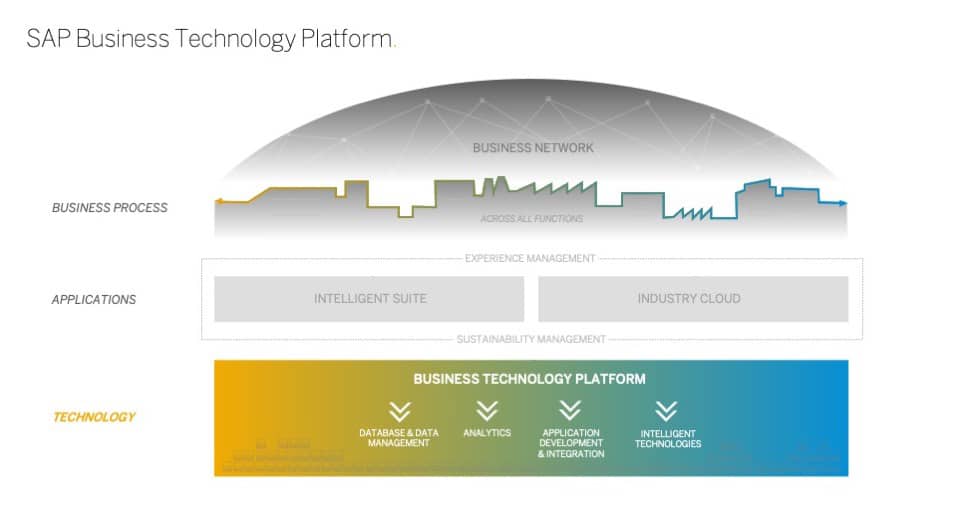Throughout the last year our “business as usual” was turned upside down. What became clear: companies with a digital mindset and framework have been at an advantage to navigate the crisis.
In a only few months, the COVID-19 pandemic has advanced the digital transformation of supply chain and customer activities as well as internal processes by three to four years, according to a recent McKinsey study. However, while most companies note the strategic importance of technology for their competitiveness, many are uncertain about the next steps. Regardless of where these companies are on their own transformation journey, we want to support their unique digitalization needs, help them become resilient, and enable them to respond to new requirements with agility and speed.
That’s why today, SAP announced RISE with SAP, our concierge service to the Intelligent Enterprise. Ultimately, the intelligent enterprise strategy is about integrating data and processes across all lines of business, and SAP Business Technology Platform (SAP BTP), as its technological foundation, plays a pivotal role in making this happen.
We recognize that to truly transform, a business requires a holistic approach. The RISE with SAP offering therefore also includes access to SAP BTP capabilities in the areas of application development and integration, database and data management, and analytics, as well as intelligent technologies. These capabilities allow customers to easily extend and integrate with any other SAP, partner, or third-party solution, both in the cloud and on premise, and enable them to turn their data into value.
One Platform for Integration, Extensibility, and Data-to-Value
There are three main challenges customers face along their business transformation journey that I keep hearing over and over again.
Customers operate in increasingly complex IT environments, ranging from everything between on premise to cloud, across multiple vendors, own legacy applications, various platforms, and open-source technologies. The Wall Street Journal reports that large companies maintain 129 different applications on average, with the total number increasing by 68% since 2015. Every operational system requires context-relevant data models, business logic, and process definitions. Integrating these systems becomes a precondition to ensure these key components understand each other across a company’s systems and business processes.
One of our customers, Eneco, a utilities company from the Netherlands with about 3,000 employees and over €4 billion in revenue, was able to cut down IT spend for integration middleware by around 50% of its total cost of ownership (TCO) in a matter of weeks. The company used the capabilities of SAP Integration Suite to implement an end-to-end process from designing a product to operations and further used it to integrate between all SAP and third-party systems.
The current pandemic has painfully shown how important it is for companies to manage their supply chains flexibly in response to volatile markets and changing requirements. New digital business models are also becoming a serious threat to established companies. Innosight estimates that while in 2016 the average company lifespan on the S&P 500 was 24 years, companies will only have a 12-year tenure by 2027. To make sure businesses stay relevant and seize new opportunities quickly, they need to be able to flexibly build, extend, and enhance their core processes and applications.
Uniper, an innovative energy company operating in 40 countries, is quickly transforming itself into an industry leader in the cloud using several capabilities of SAP BTP, including SAP Extension Suite and SAP Intelligent Robotic Process Automation. This helps the company to streamline and digitalize its operations across its plants, the field and the back office. By doing so, it could save 50% of time used on plant inspections and achieve 10-times faster data entries for job requisitions.
Businesses also require a singular data view and simple access to all their enterprise data. But while data sources, types, and volumes continue to increase, the dilemma is that companies struggle to make use of it and create business value. A study by NewVantage Partners reveals that 69% of companies do not follow a data-driven approach. Federated data access and consistent information on data semantics and relationships between objects becomes essential for them to get one single source of truth and real-time insights into all processes across the company.
Swisscom AG, a telecommunications company with more than 19,000 employees, needed to find a way to simplify its real estate operations and reporting so that it is more intuitive, context-based, and requires fewer steps to build a dashboard. With the help of SAP HANA and SAP Analytics Cloud among other solutions, the company cut the time it took to create reports by half and could reduce front-end issues by 90%.
 Here are some additional updates that I would like to share concerning the future of our platform:
Here are some additional updates that I would like to share concerning the future of our platform:
ONE Platform
In line with our goal to establish SAP Business Technology Platform as the platform for the Intelligent Enterprise, we decided to sunset the “SAP Cloud Platform” product name to avoid confusion with the SAP Business Technology Platform brand. While the actual cloud platform capabilities are renamed — for example, “SAP Cloud Platform Integration Suite” becomes “SAP Integration Suite” — the products and services continue to be available, their functionality and agreements will stay unchanged, and the services will remain as important as ever.
A Strong Partner Ecosystem
Additionally, many parts of our strategy build on the successful collaboration with our partners. They are essential for establishing a harmonized product architecture across the entire ecosystem and to facilitate integration and interoperability, or to give our customers infrastructure flexibility. As part of this, a few days ago, SAP and Microsoft announced the expansion of their existing partnership, including a continued commitment for the collaboration in the technology space. By combining SAP BTP and Microsoft Azure, we will continue to improve availability, integration, connectivity, and security for SAP solutions on Microsoft Azure. This includes event integration, simplified administration and provisioning, faster landscape creation provisioning, and more.
The Foundation for Your Transformation
I’m convinced that technology can help companies achieve their business objectives, no matter how siloed their internal structures might be or how far they are in their digital transformation journey. For almost 50 years, customers have relied on SAP to run their business processes, most recently applications within the intelligent suite and SAP’s industry cloud. To further drive their business transformation, intelligent enterprises need additional flexibility and independence to move their assets to the cloud, integrate their IT landscape, and configure and extend their SAP applications.
This is what SAP Business Technology Platform is all about: a business-centric and open platform that provides our customers with the technology they need to transform their business and prepare for a new digital future.
For more information about RISE with SAP, read blogs from Christian Klein, Thomas Saueressig, and Uwe Grigoleit, as well as an interview with Jan Gilg.
Juergen Mueller is chief technology officer and member of the Executive Board of SAP SE.



